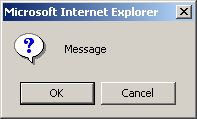Java Script confirm Message Box
By Stephen Bucaro
In Java Script programming, there are many occasions when you need to display
a short message to the user, or request a bit of information from the user.
In these instances, you can use a message box.
Java Script provides three types of message boxes, the alert, confirm, and
prompt. They are all easy to create and use.
• These message boxes are "modal" dialog boxes, meaning that
program flow halts while the message box is visible. The user is unable to use
the page that spawned the message box until they click on a button to close the
message box. This may be disruptive to the user. You can also design your own
custom message box, which you may or may not choose to make modal.

A confirm presents a message with an [OK] button and a [Cancel] button.
If the user clicks on the [OK] button, the confirm dialog box returns true.
If the user clicks on the [Cancel] button, the confirm dialog box returns false.
Clicking on either button dismisses the dialog box. Example code to create a
confirm message box is shown below.
if(confirm("Message"))
{
alert("User clicked [OK] button");
}
else
{
alert("User clicked [Cancel] button");
}
A confirm message box can be used to ask the user if a certain function should be performed.
if(confirm("Perform function?"))
{
// Code to perform function
}
More Java Script Code:
• Generating Random Numbers
• Define Lines in a String
• Find a Character or a Substring Within a String
• Java Script alert Message Box
• Use Escape to Replace Dangerous Characters
• Convert a String to a Number
• Search and Replace Strings
• Accessing Web Page Elements
• Interactively Set Webpage Colors
• The Document Object Model (DOM)
| 
